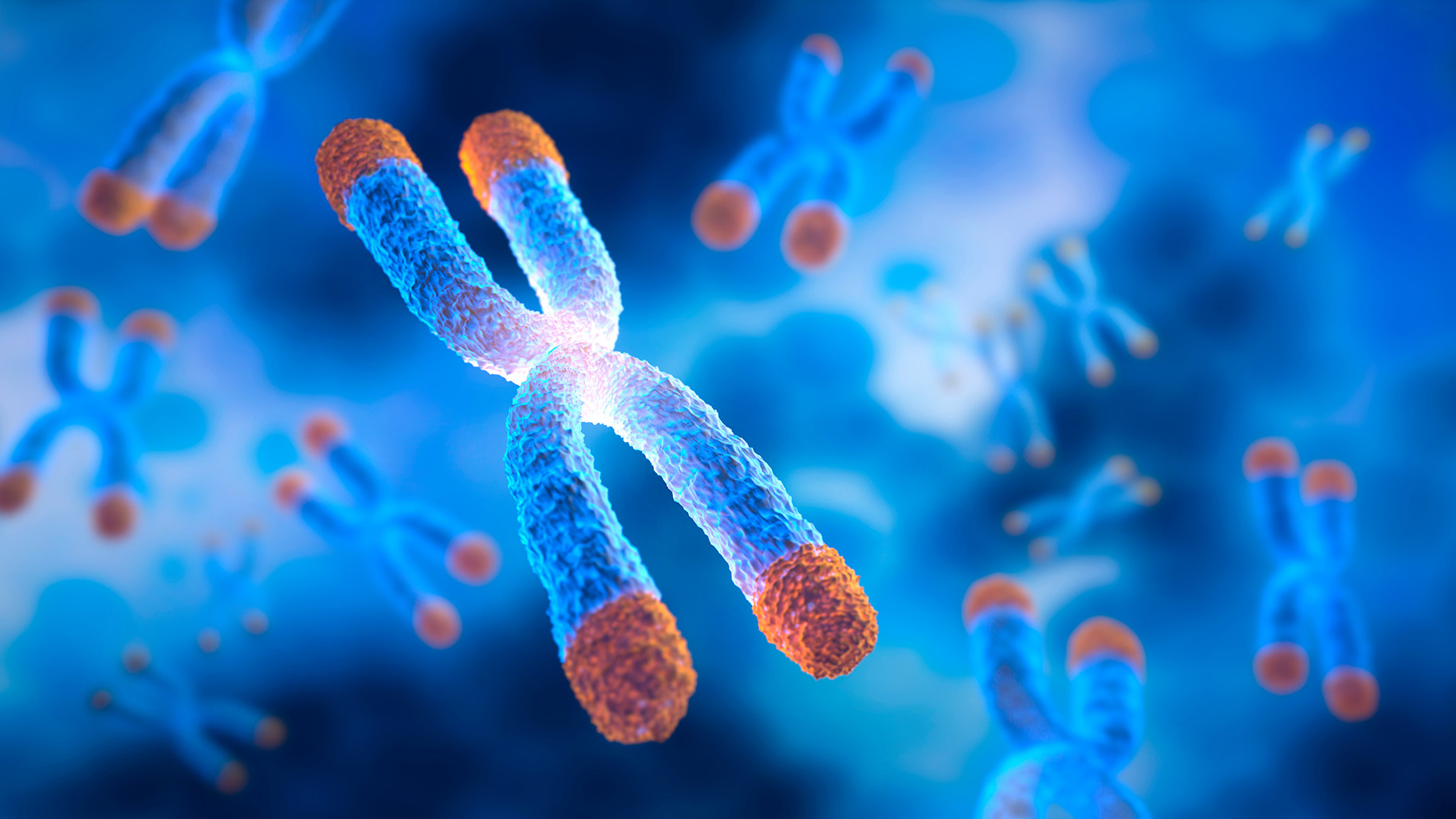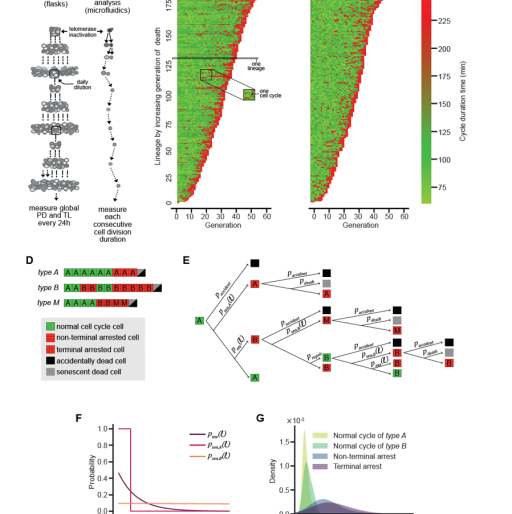
Understanding cell ageing
It’s no secret for biologists; the shortening of telomeres, (the ends of our chromosomes), which occur with each cell division, ultimately trigger the cell’s senescence and the gradual deterioration of its functioning. One question remains to be answered, however. Is senescence signalled by average telomere length or the length of the shortest telomere? The issue is all the more critical given that the onset of senescence, or the mechanisms which enable certain cells, such as cancerous cells, to avoid this, lie at the core of research in ageing and the fight against cancer.
To answer this question, Teresa Teixeira, researcher at the Institute of Physico-Chemical Biology (IBPC) and Zhou Xu, researcher at the Paris-Seine Institute of Biology (IPBS), used an innovative technique called microfluidics, enabling them to observe up to 100 consecutive generations of yeasts. Their research indicated that the shortest telomere is the determining factor in the senescence of cell lines which develop normally (named ‘type A’ by the researchers). However, a model had to be found to confirm this.
Using mathematical tools to produce models
To address this challenge, in 2013 the two scientists called on the Mamba joint project team (INRIA and Sorbonne University), led by Marie Doumic. This marked the start of a lengthy collaboration, which is currently being pursued by the newly created Merge team at the INRIA Saclay centre.
Verbatim
Biologists are capable of producing an impressive amount of data with remarkable accuracy, but the potential difficulty is knowing how best to use it. ‘That’s where we mathematicians can help. We work with them to develop model hypotheses to explain their data.
Responsable de l'équipe-projet MERGE
A model developed in 2015 with doctoral student Thibault Bourgeron to simulate telomere shortening in yeast populations proved successful. The model confirmed the hypothesis that the shortest telomere is the determining signal of senescence. This initial result encouraged the researchers to go further.
‘In Teresa’s and Zhou’s initial studies, another type of cell line, called type B, was identified’, Marie Doumic explains. ‘This type did not develop like type A, but presented non-terminal arrests: the cell arrested its development, started again, stopped, then entered into senescence at some point. We didn’t manage to understand this mathematically during the first thesis, so we launched a second one.’
From a cellular scale to population modelling
PhD student Hugo Martin thus combined biological data with standard statistical methods and mathematical models. The result revealed that division cycles of this cell type follow a geometrical law at each division, they have a constant chance of dying and a constant chance of repairing themselves. The probability of these arrests also increases with every division. ‘These results applied on a cellular level, but we then had to transpose them to a model representing what happens on the scale of the population’, the head of Merge points out.
A third PhD student, Anaïs Rat, took over and calibrated the model on microfluidic data to incorporate it in a full model representing telomere shortening in the population. The junior researcher then discovered that in type A lines, the average telomere length, which despite not being a decisive factor on the cellular scale, constitutes a significant element in anticipating the proliferation abilities of a population. The research (publication forthcoming) demonstrates that for type B lines, however, senescence develops independently of the shortest telomere, and is based on chance, contrary to type A. This result offers new prospects in the study of so-called ‘surviving’ cells’, i.e. those that escape senescence, even in the absence of telomerase (the enzyme which restores telomeres). This is the cell type cancer researchers look closely at.
Modelling their behaviour, and the improvement of existing models to obtain even faster digital simulations will form part of the projects developed by the new Merge team, which will pursue the research previously carried out by the Mamba team.
The collective wealth of comparative views
A new thesis, currently being led by Jules Olayé and co-supervised with Milica Tomasevic, is exploring the development of a telomere shortening and lengthening model. Thanks to funding via the Maths-VivES priority exploratory research programme (PEPR) and the ANR (National Research Agency), the researchers will continue to deepen knowledge in biology. ‘We’re lucky to be working with biologists who believe in what we are doing’, Maris Doumic is glad to admit. ‘And the simple fact of talking together and sharing our views on each other’s work helps us to move forward, raise new questions and explore new hypotheses. This is the strength of interdisciplinary work.’
Merge will be resolutely interdisciplinary. It is precisely the prospect of combining partial differential equations with probabilities, modelling and biological data which convinced Marie Doumic to lead this project team drawing on the joint involvement of INRIA, CNRS and Ecole Polytechnique, a member of the Polytechnic Institute of Paris. The research projects will also be varied, even if they all stem from life sciences.
Multiple projects to address the same type of issue
Researchers Sylvie Méléard and Vincent Bansaye work alongside the doctors of Saint-Louis Hospital on blood cell differentiation models in the development of leukaemia; with Gaël Raoul and in collaboration with ecologists, they study issues of species’ adaptation to climate change or interactions between species, while others explore resistance models in bacteria or the emergence of mutations in the latter.
‘This may seem like a multitude of unrelated projects, but they are actually all connected’, Marie Doumic tells us, ‘because they all call on similar mathematical models and methods, which we’re developing to resolve this type of issue.’ The research on telomeres thus benefits not only biologists working on ageing and cancer, but also the whole ecosystem drawing on the expertise of the new Merge team.
Find out more
General audiences
- Optimizing cancer drug therapies, Inria, 08/02/2021.
- Modèles mathématiques et simulations numériques des maladies [Mathematical models and digital simulation of diseases], Marie Doumic Jauffret (video), Inria, 20/04/2017.
Experts:
- ZOOMinar on "Proteinopathy", Per Westermark and Marie Doumic, Amyloid Symposium, 9/1/2023.
- Des probabilités pour le vivant [Mathematical probabilities for life], Vincent Bansaye, Soirées Mathématiques de Lyon, 11/3/2019.
- Darwin, le hasard et l’évolution [Darwin, chance and evolution], Sylvie Méléard, Un texte un mathématicien conference cycle, 3/4/2021.
- Mathematical models in ecology, Gaël Raoul, “Mathematical summer in Paris”, 19/7/2021.
